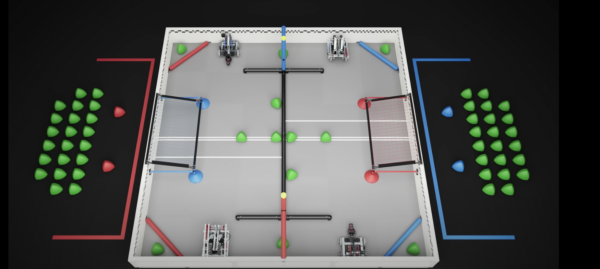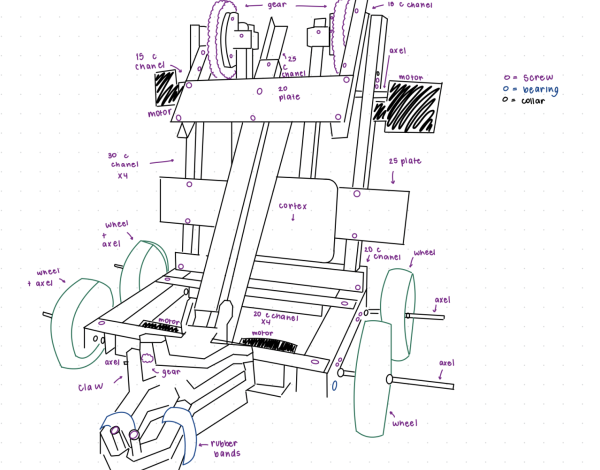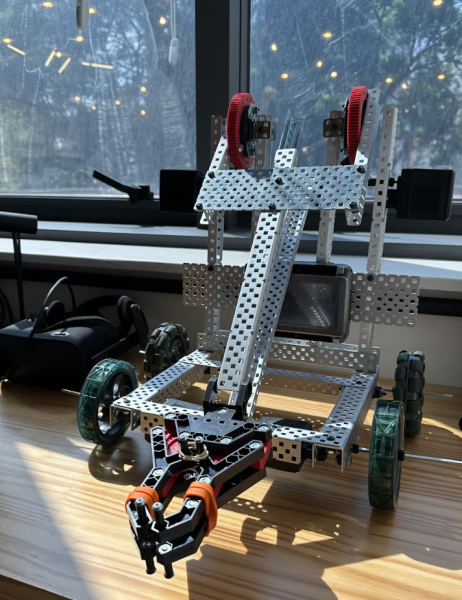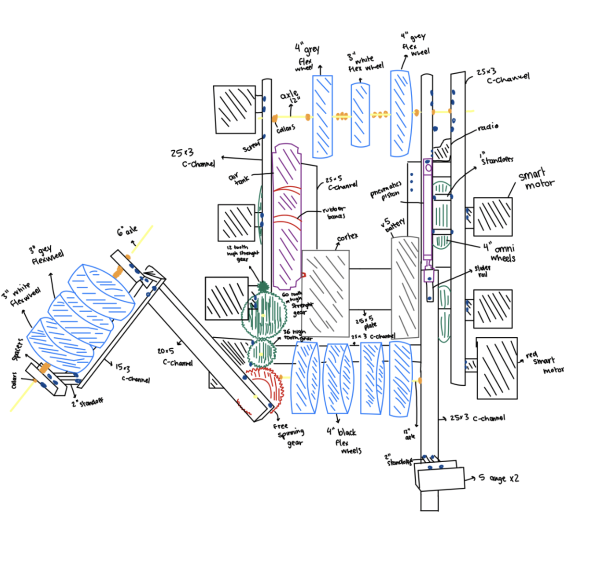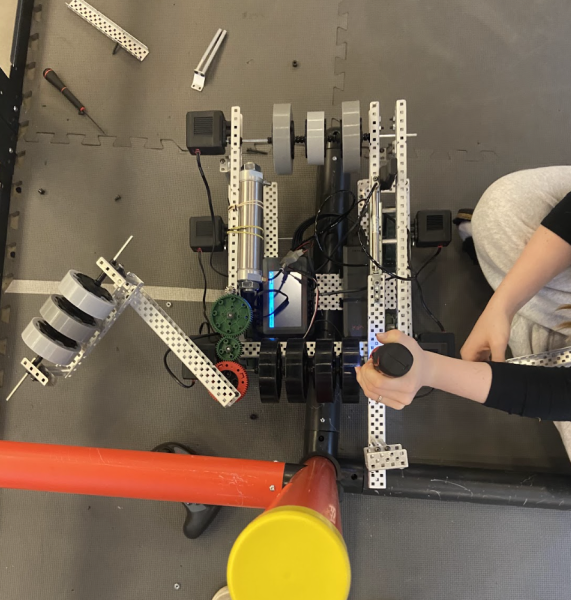In the world of robotics, anticipation is growing as next year’s VEX Over Under competition slowly approaches. Robotics competitions have forever been an incredible demonstration of the fun side of STEM education, and this semester, the Robo Eagles eagerly prepare for the upcoming Over Under competition, which will be in Canada, and the VEX robotics world championship, which is set to take place in the USA. In this article, we dive into the excitement of the competition, explore the intricacies of robotics, and shed light on the work underway and the remarkable journey our students and mentors are starting.
The Challenge
For this competition, students must build a robot to complete a given challenge effectively and efficiently. The challenge takes place on a field, and two teams (red and blue), each consisting of two robots, need to compete against each other to get a higher score by scoring the most tribals (triangle-shaped plastic balls, shown in green in the photo below) in their respective goals. Additionally, the robot needs to elevate itself on beams in the middle of the field, and the robot that manages to elevate itself the highest gets more points. There will be sixty total triballs, and the robots should be able to pick them up, carry them around, and place them under the goal. Lastly, as stated, the robot needs to lift itself up the elevation beam. Each triball scored in a goal is worth five points, and each triball scored in an offensive zone is worth two points. So far, the fearless advanced robotics students have split into pairs in order to build the VEX “recommended” robots, which, on a good day, work about 5% of the time and can’t even climb up the elevation beam. Overall, we aren’t putting too much faith into these, which is why we have also started to work on a second round of robots.
The Classic Clawbot Design
Two of the groups opted for the tried and true clawbot design. Clawbots are made of four wheels, a small compact base, and a long neck with a claw at the top. This fantastic design enables the claw bots to deftly pick up, throw tribals, and grab onto the elevation beam. However, the initial design poses a challenge: since the robot is heavy, the simple clawbot needs more strength to hold itself up on the beam since the robot is heavy. Undeterred, the second team is working to enhance the claw’s abilities by enlisting the help of a new VEX piece, which works as a gear system and a robust base for the claw. This ingenious gear system will strengthen the whole bot, therefore serving as a shining beacon of hope for the students on teams 1 and 2. This build has not yet been tested but holds the promising potential to be an innovative solution and possible game changer.
Taking Risks: Air Tanks and Treads
Meanwhile, the third team is currently building a robot with dual air tanks strategically positioned on each side. In their quest for the elusive air tanks, the students went on a daring mission through the dangerous undergrounds of Graded, leaving their fellow students in awe of their adventurous spirit. While this pair remains confident that their design will work, the others are excited to know if this air tank idea is the key to finally solving the elevation challenge. It uses rubber wheels placed on an axle in the middle of the robot to move tribals into the base, and the air tanks then pump up air to move the robot over the middle beam. Lastly, the fourth team is building a very similar design to the first one, which uses wheels and tank treads to load the tribals into the robot and uses an extendable claw to climb up the elevation beam. They work in stealthy silence, leaving the class in suspense. However, they might be the first team to finish their bot and successfully complete the challenge, seeing as they are way ahead of everyone else. While none of these robots have been tested or coded and are still in the building stage, everyone is determined to find a solution to the expansion challenge and, to an extent, to build a successful final robot for the competition.
Traveling
The class is highly excited to travel to Canada and compete together for a chance to showcase their hard work and creativity. They are looking forward to having fun competing and getting to know other robotics students. When asked what he thought about last year’s VEX championship, Mr. Hudson stated he “loved seeing all the different students from different places coming together and sharing experiences.” He said, “Everyone was so open-minded and eager to help.” He explained that the team faced a problem with the code on the day of the competition, and they “met some students who taught us how to fix it,” which was nice because “there was no competition or animosity” and “everyone was super friendly, and we had a lot of fun.” As we’ve discussed the details of this year’s challenge and the robots currently being built, it is clear that the robotics team’s journey promises to be filled with excitement and innovation. Graded will be the only Brazilian team competing in Canada, and students can keep updated through the robotics team’s Instagram, @robo_eagles37474A.


